Guatemala in one word? Perfect. I had such a great time here that it is difficult to put into words. The trip was full of variety and as such, very little rest, but I was determined to cover as much ground as possible. From San Salvador, El Salvador, there is a direct coach bus (5-8 hours depending on which border is open at the time and how long you spend there waiting to cross) to Guatemala City. From there, it is about another hour by minibus to Antigua.
Antigua
This beautiful cobblestone lined colonial city is a UNESCO World Heritage Site with many 16th century architectural structures (mostly former churches, monasteries and convents) there that were severely damaged by earthquakes in the 1700s. The ruins now showcase the history of the area and serve as reminder of the resilience of the Guatemalan people.
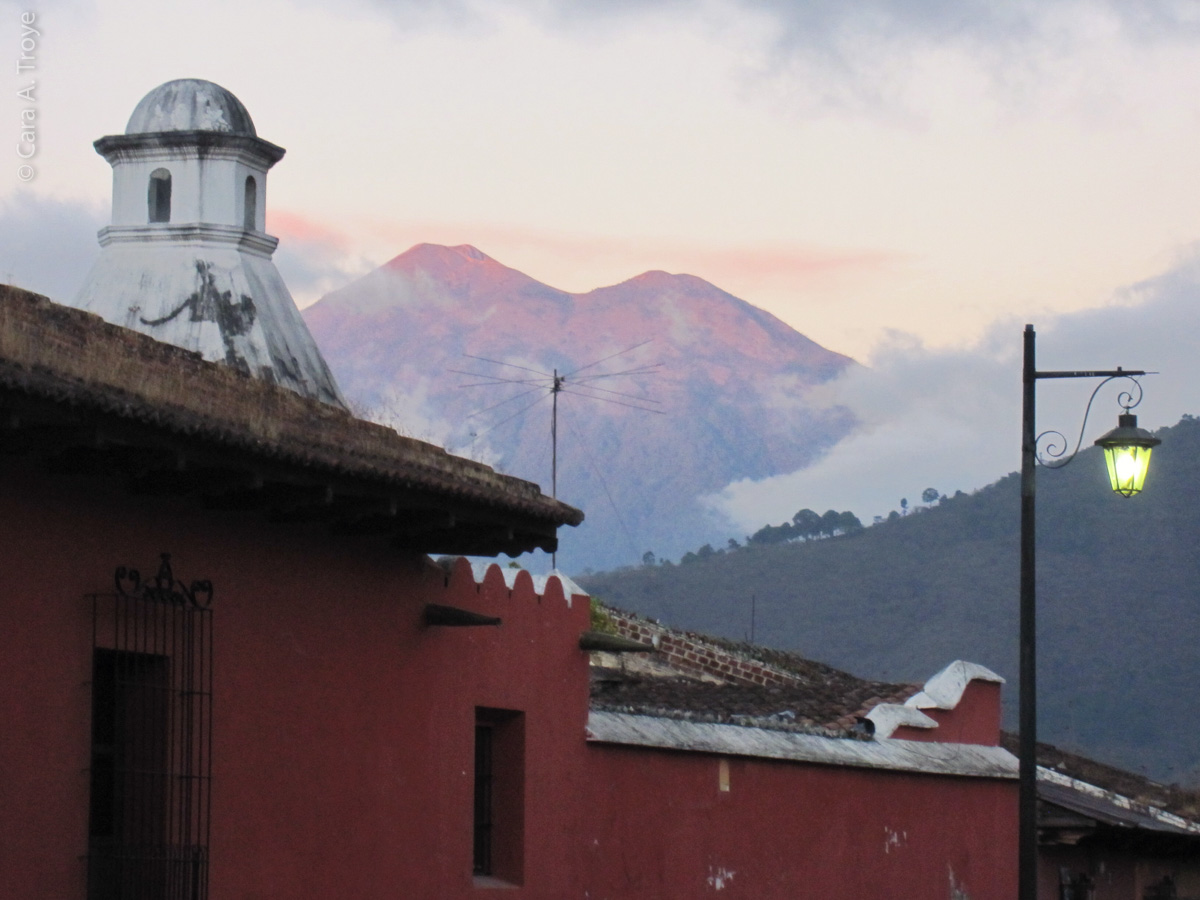
Early mornings are beautiful and quiet in Antigua – perfect for walks and photographs.

Antigua – this UNESCO World Heritage Site is home to several active volcanos.
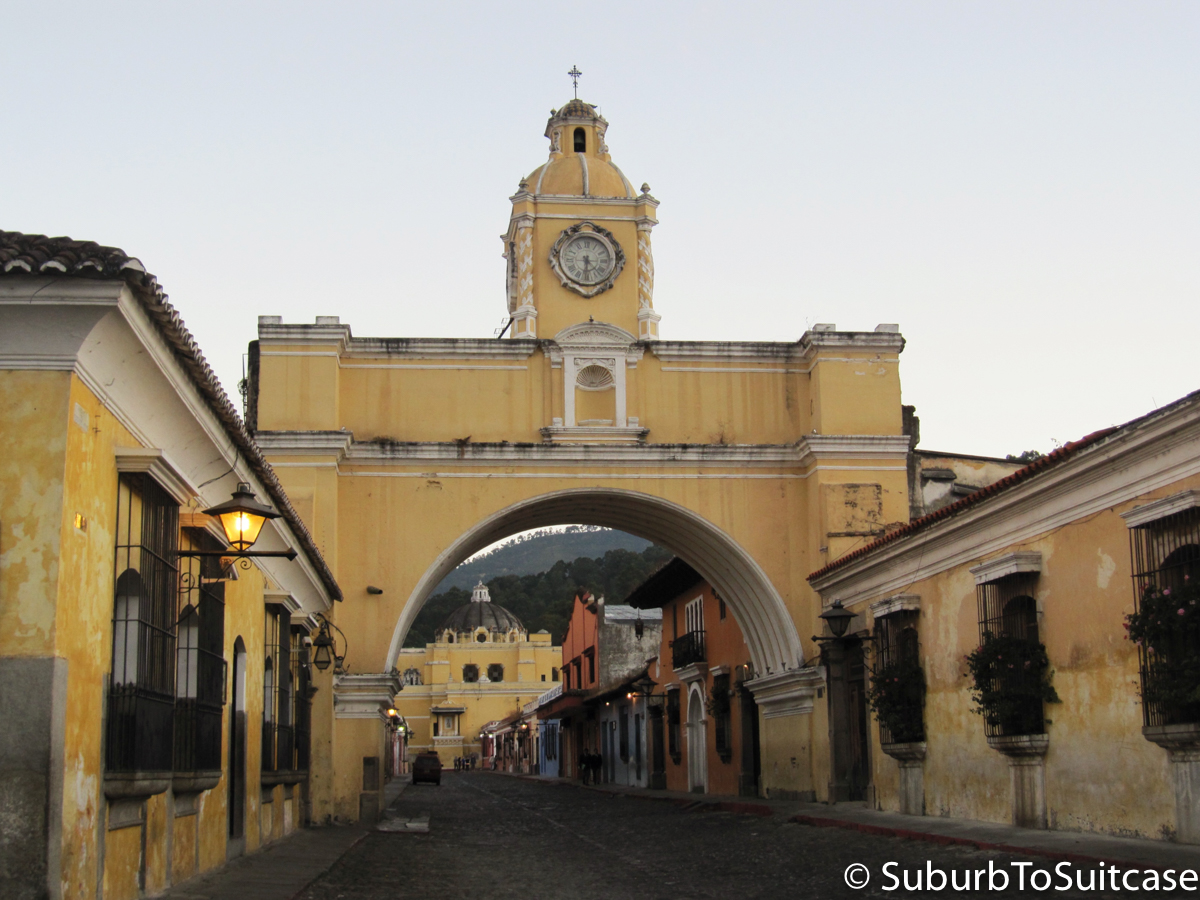
Arco de Santa Catalina in Antigua originally connected the Santa Catalina convent to a school, allowing the cloistered nuns to pass without using the street.
It surprised me that with so many amazing ruins in a small area (most everything is within an eight block range), there were times when I was the only visitor at a particular site. This was really a blessing because at those times, I was able to process my thoughts without interruption, move at my own pace and capture some interesting photos.
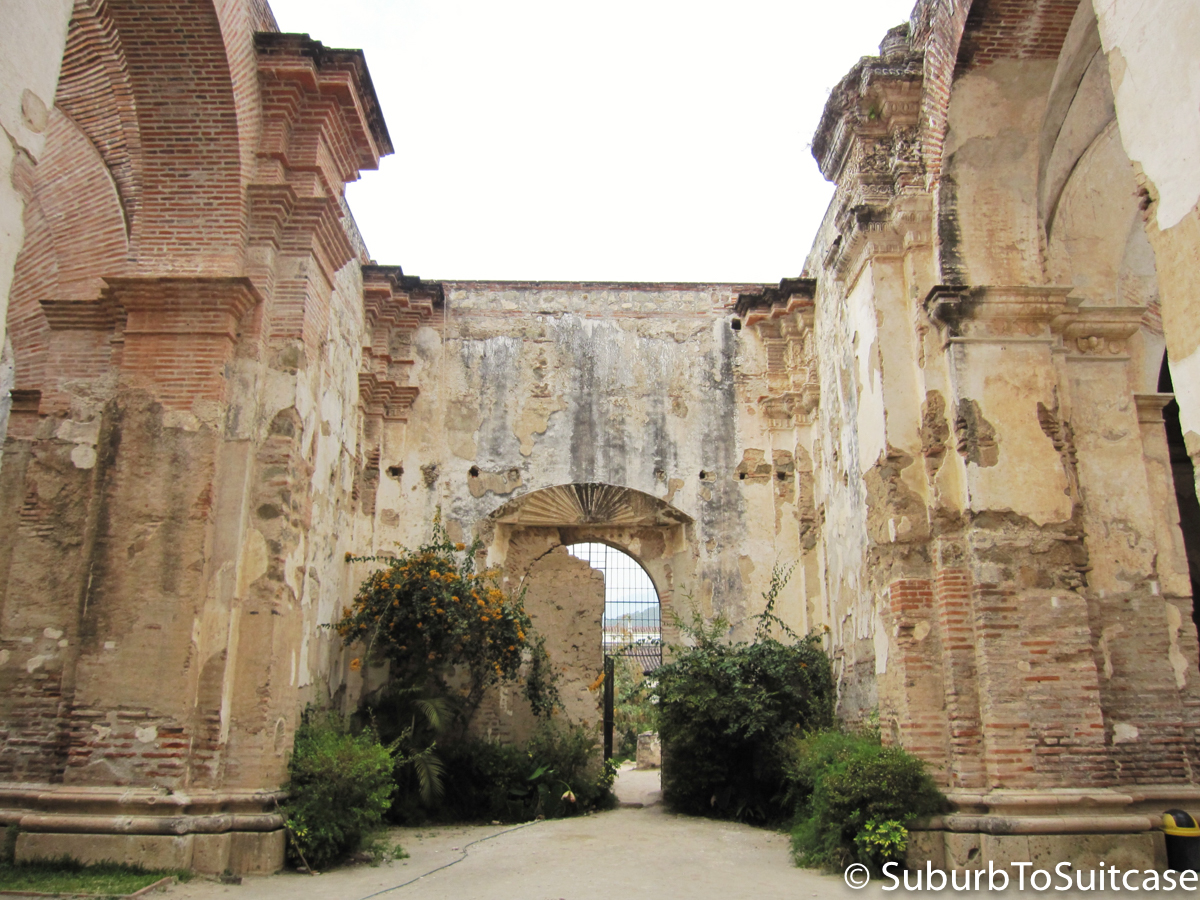
At Catedral de Santiago in Antigua, you can explore above and below ground ruins.
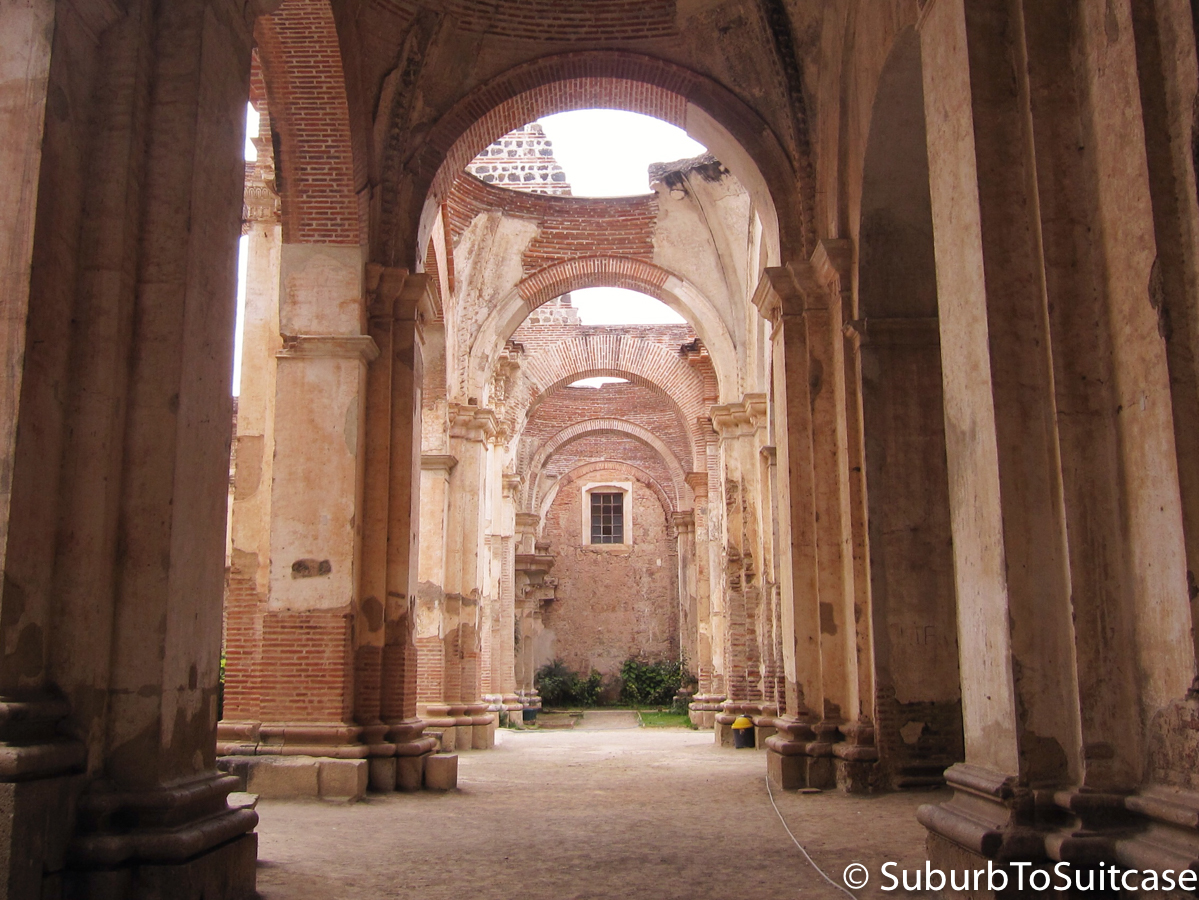
Construction began on Catedral de Santiago in the mid 1500s and it was later devastated by the earthquakes of the 1700s.
As I explored the ruins of San Francisco, I stopped at one point, in order to appreciate the surroundings. I thought about those whose footsteps I might be walking over and about the people whose lives might have been lost right where I was standing. It was peaceful but almost overwhelming. Shortly thereafter, a bold tourist motioned to me that I should really go into the room a few steps away where the artifacts were held. He said “You should go in there. That’s where the important things are. The rest is just wind.” I smiled and politely thanked him but I remember feeling very put off. It reminded me that no two travel experiences are the same and people absorb and process experiences very differently.

Dating back to the 16th century, Iglesia de San Francisco is one of the most spectacular ruins in Antigua (Peter of Saint Joseph Betancur is enshrined here).
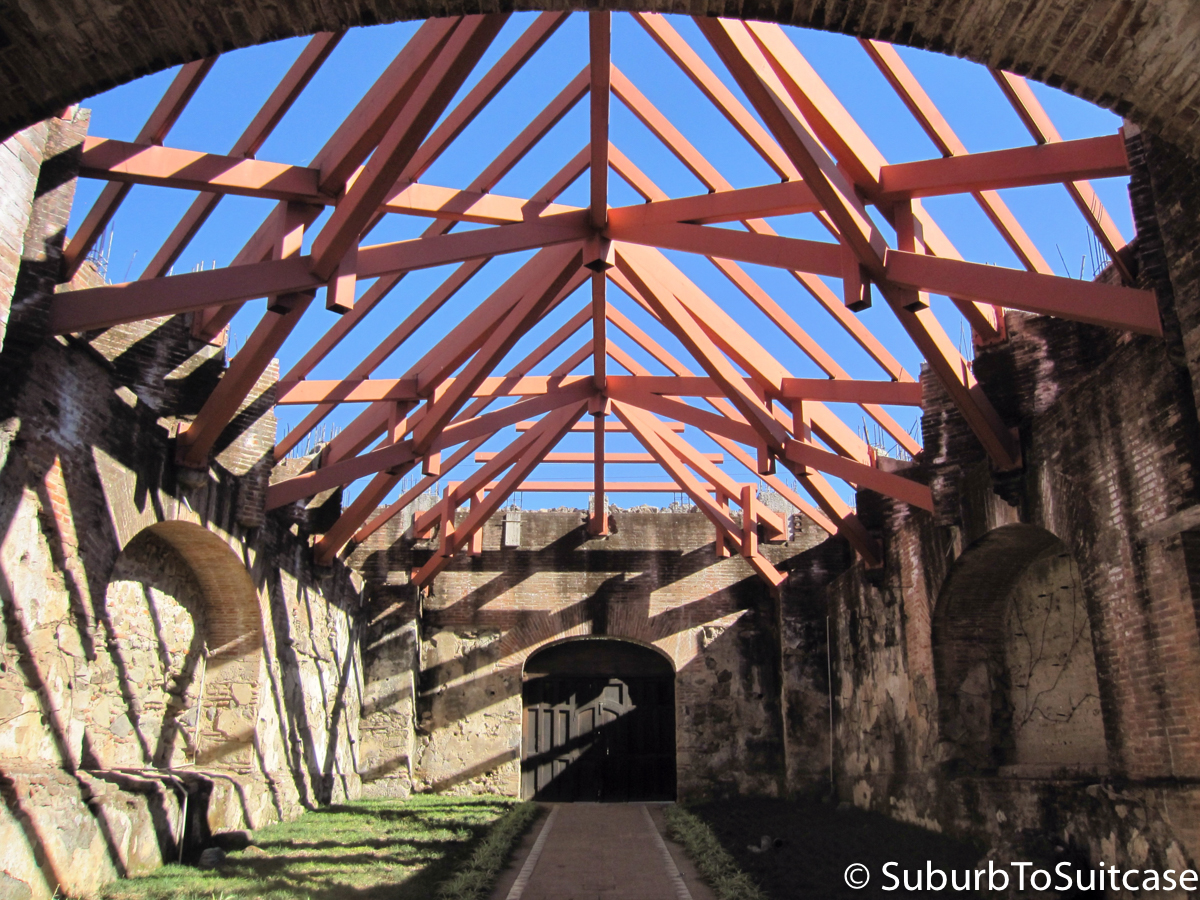
Santo Domingo is a former monastery open to the public for viewing, including galleries, museums (above and below ground), as well as preserved historic areas (tombs, gathering rooms, etc.).
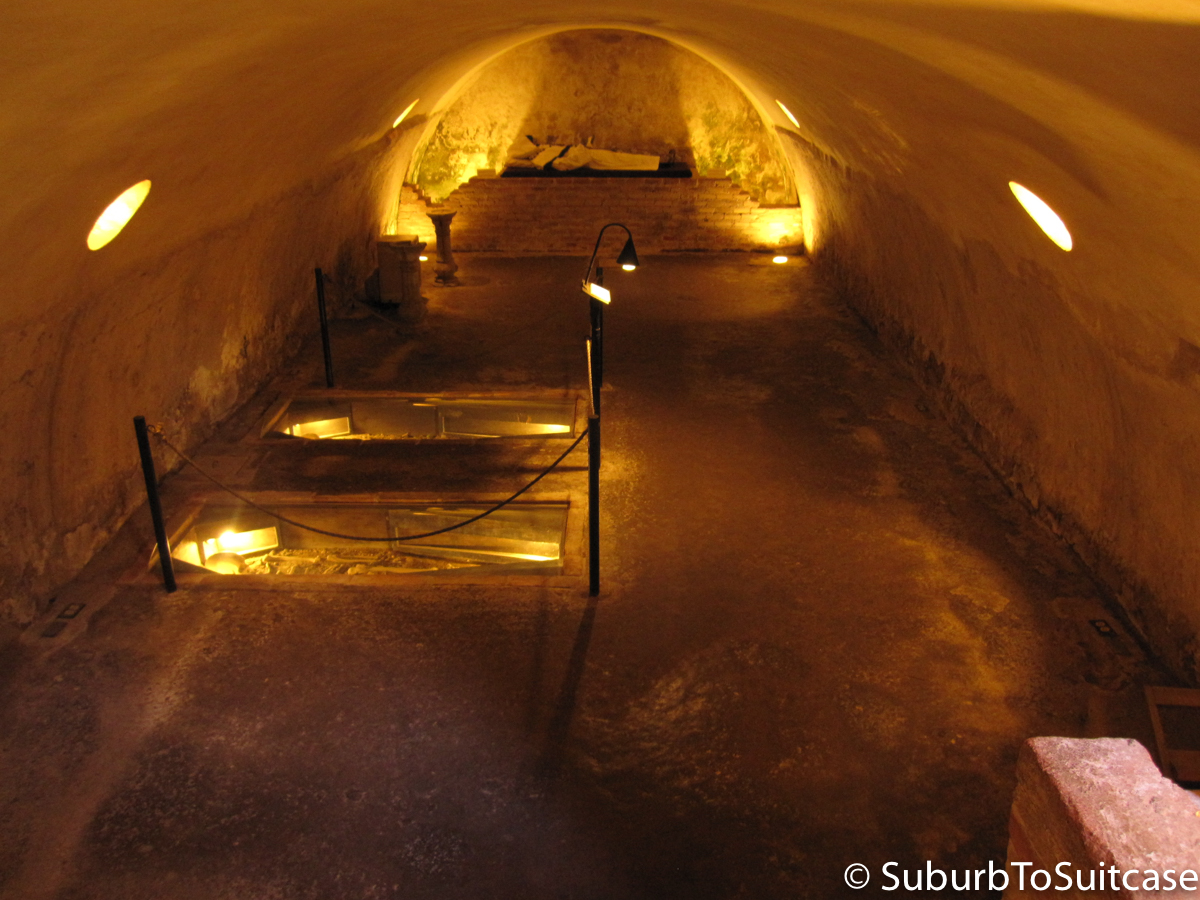
Inside the underground catacombs at Santo Domingo
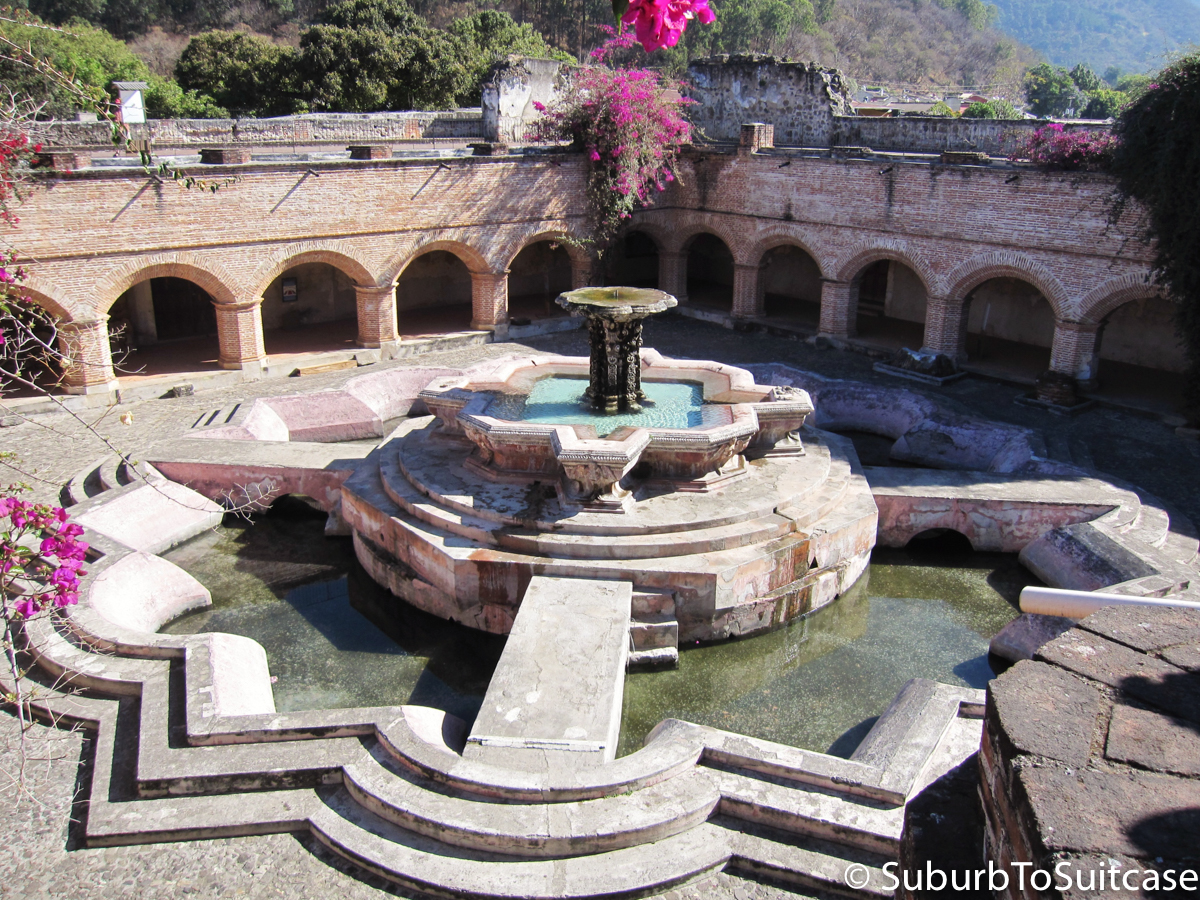
There are beautiful views everywhere you turn at La Merced in Antigua.
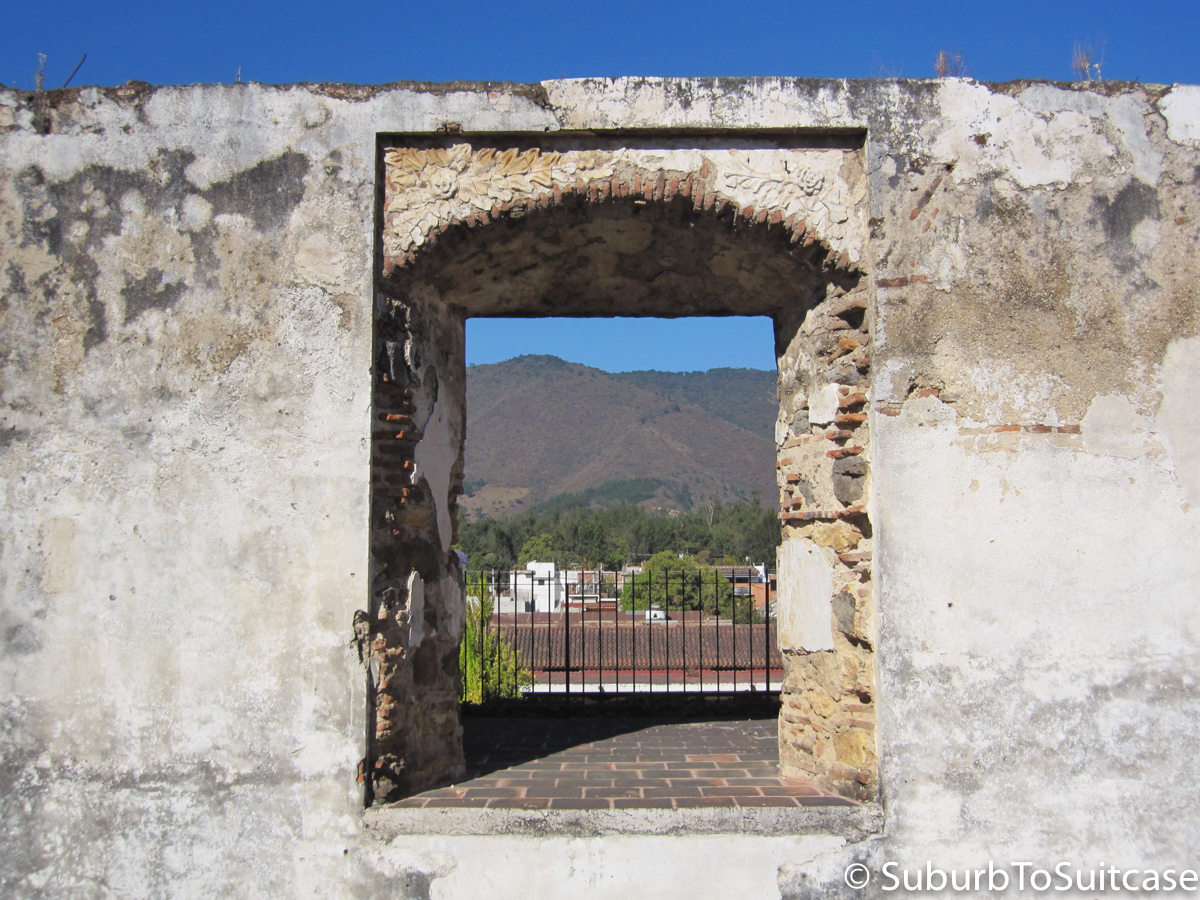
Window at La Merced – the surviving architectural details in the ruins are remarkable.
I remember my visit to La Recolección, specifically. I walked there early in the morning so I had the grounds to myself. My guess is that since this is the farthest away from the central part of town, a bit more pricey for admittance and kind of tucked away beyond the steel bar fence, perhaps it is generally less visited. Either way, it allowed me to spend time talking with the security guard/gardener and learn more about the area that once boasted an enormous compound with magnificent church, monastery, library and infirmary.
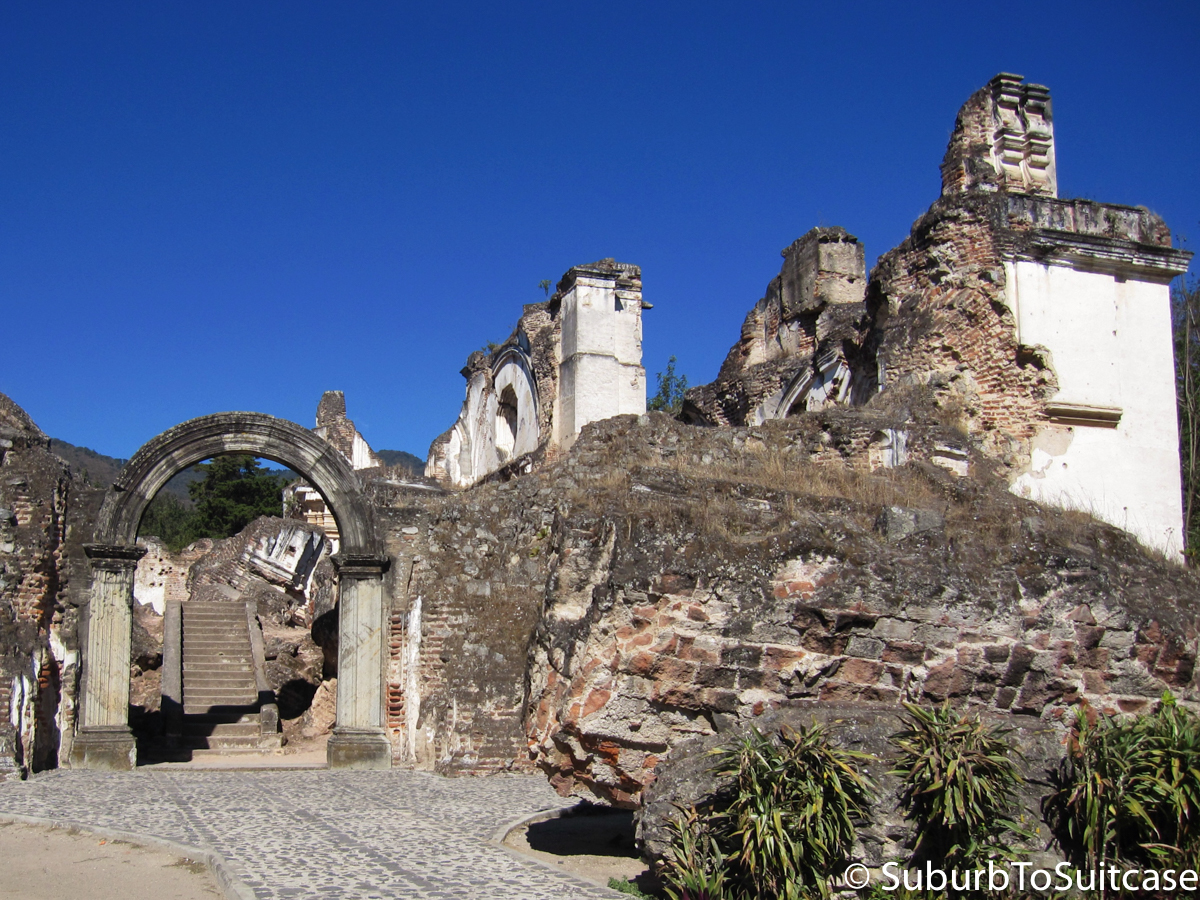
This former church and monastery of the Order of the Recollects was built in the very early 1700s, including a series of cloisters, the church, library and infirmary.
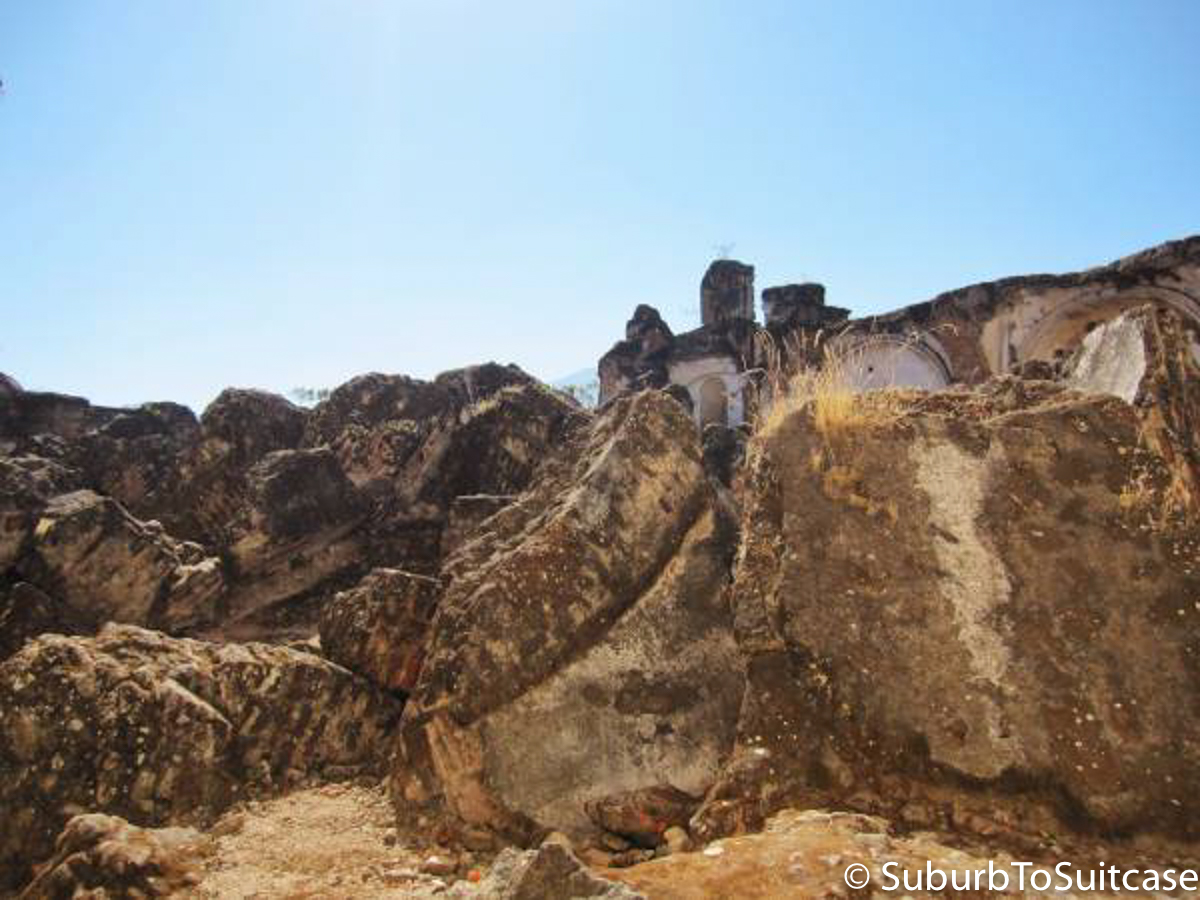
Even after the 1717 earthquake, 35 friars still called this location home. Subsequent earthquakes in 1751 and 1773 caused the impacts seen today.
I was taken by the size of the structures still present and the devastation that is now marked by huge portions of stone and brick walls that you have to crawl over to get through the site. As my sense of adventure and exploration got the best of me, I soon realized it was one thing getting to the top of a second floor view, but something else to scale back down. Knowing there was no one who was going to come get me (or hear me, for that matter, if I had called out), I managed to retrace the crevices in the stones where I had placed my fingers and toes on the climb up. For someone not fond of heights and unstable surfaces, this was challenging but rewarding once I made it down.
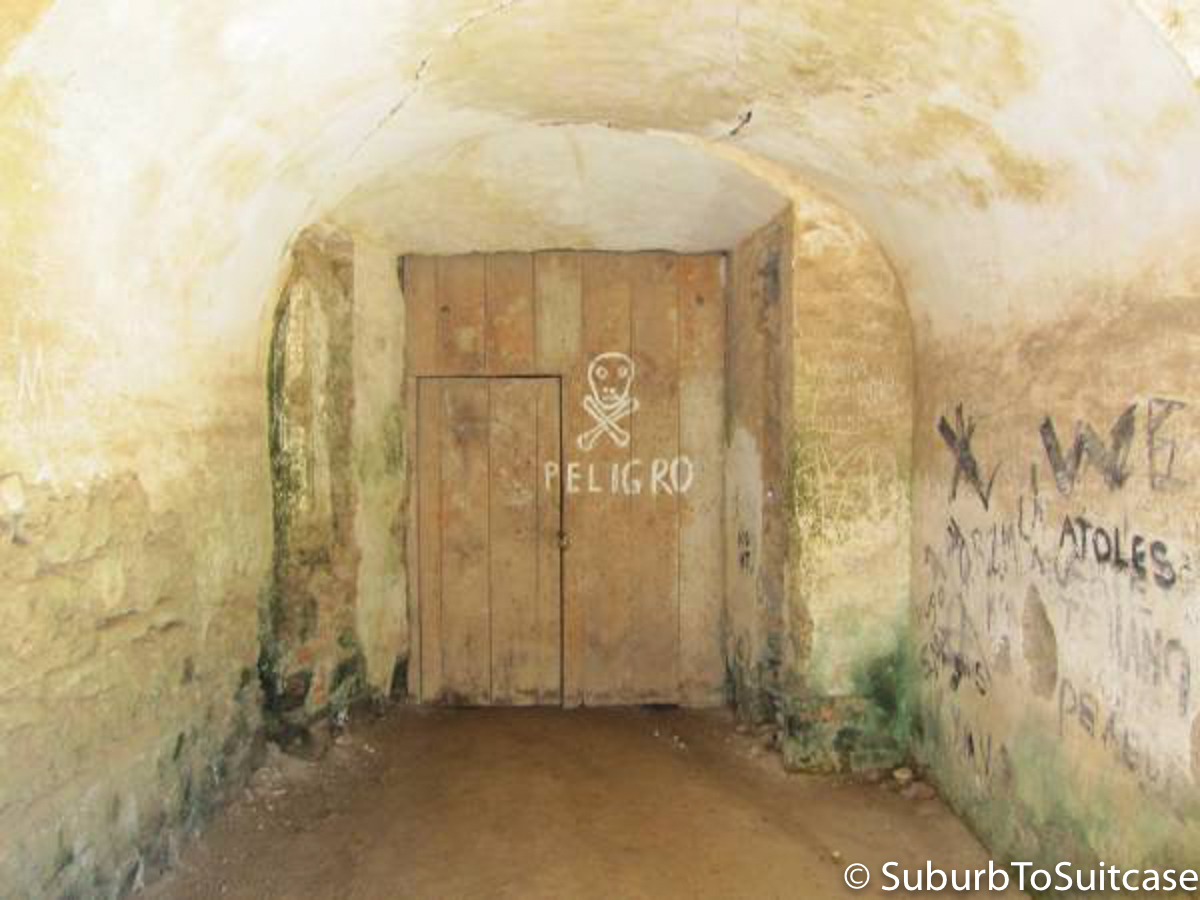
Inside a Tunnel at La Recolección
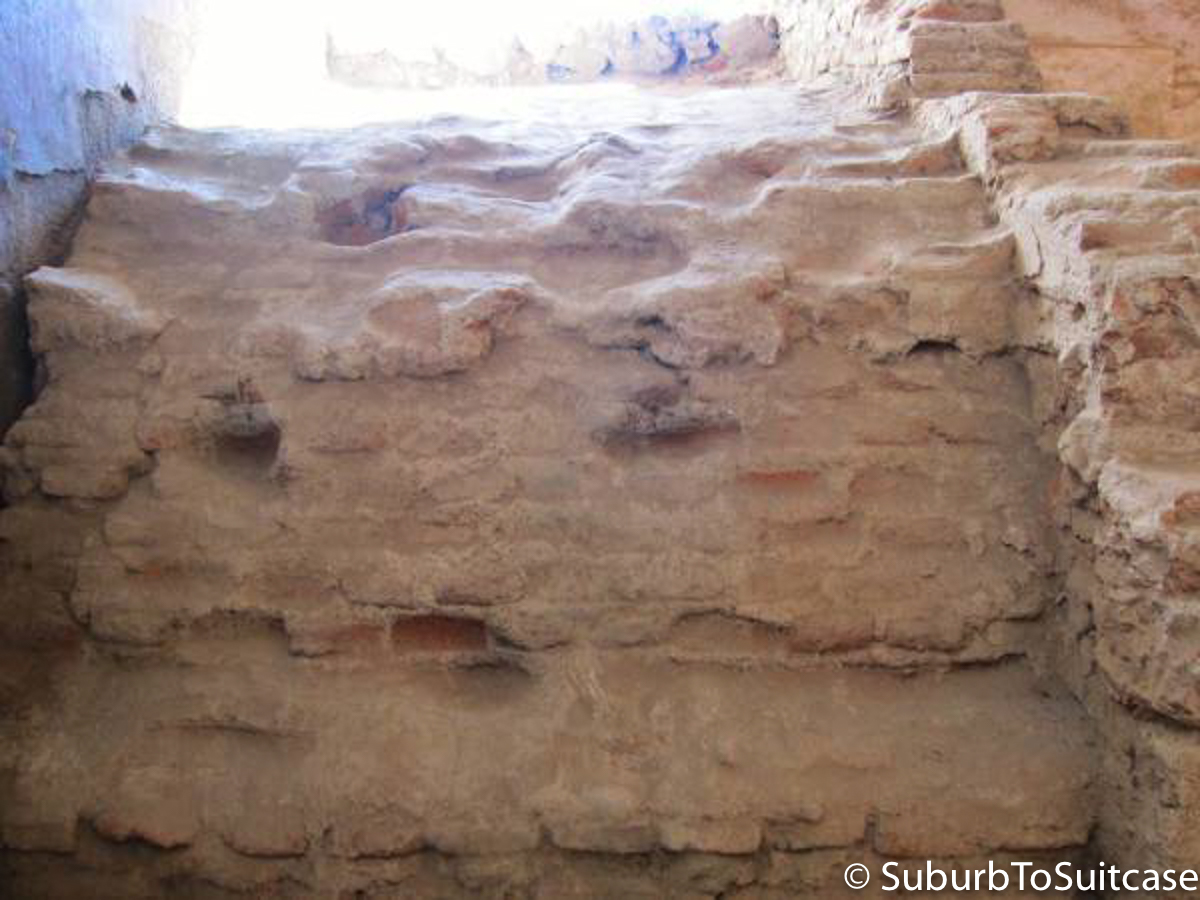
A small section of the climb at La Recolección
Several people have asked me if it is really safe to be walking around all of these remote areas. My general reply is yes – absolutely. There are so many private security, police and military guards in these areas that I felt extremely comfortable. Like anywhere, though, there are incidents so you just have to try to be smart about your choices and if you are less comfortable being out at night, enjoy your fun in the daytime. If you ask, locals will be very forthcoming with you about areas that are less safe than others (this is where speaking the local language is helpful). For example, there are guards during certain hours along the hike to Cerro de la Cruz (the cross on the big hill you can see in town) but outside of those hours, tourists are strongly warned not to attempt this. The only incident I saw in town was in the middle of the morning, broad daylight, and military were very quick to respond and apprehend the individual. Seeing this in action was intense (crime in handled very differently in different countries) but I kept moving and stayed out of the area until after it was resolved. Areas like Antigua are somewhat unique in that tourism generates much financial support, so I am sure they seek to maintain a very safe community.
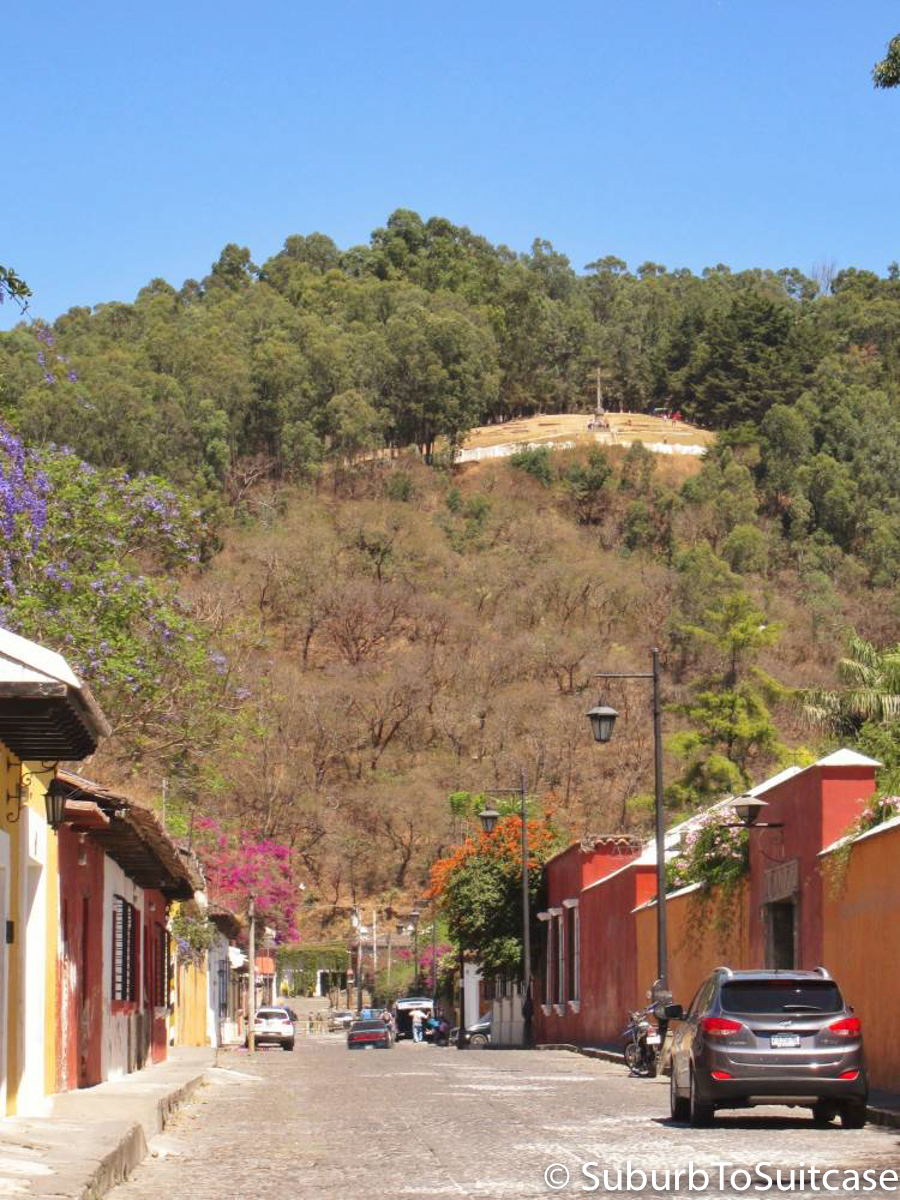
Cerro de la Cruz
Aside from the ruins, Antigua has stunning views of the nearby volcanoes amidst the picturesque architecture that looks like it could form a movie set. In direct contrast, modern-style chicken buses are everywhere. This is one of the most common modes of transportation to get around. The novelty of seeing these vehicles which are basically tricked out big yellow school buses in the U.S. does not wear off and I am convinced there is a secret language of horn patterns the drivers use. I think I need a longer trip to crack the code. Their bright colored high-gloss paint, bold decor accents (everything from religious trinkets to velvet and fringe) and unique personalization (names of loved ones, for example) make these vehicles fun and funky. It is like being at a hotrod car show except only for buses. Guatemala has so many dusty areas; however, the chicken buses are still pristine on the outside. They must wash these constantly. I’m not sure if it is a requirement or that the drivers take such pride in their vehicles, but it was really noticeable. How these drivers navigate through the twists and turns of the roads up and down the mountains keeps me in awe. Because some passages are through narrow and congested common areas, traffic may significantly impact any sort of timetable if there is an accident, weather issue, unloading of supplies in front of a store or town event along the route. You do have be careful (and flexible) when planning travel in these areas.
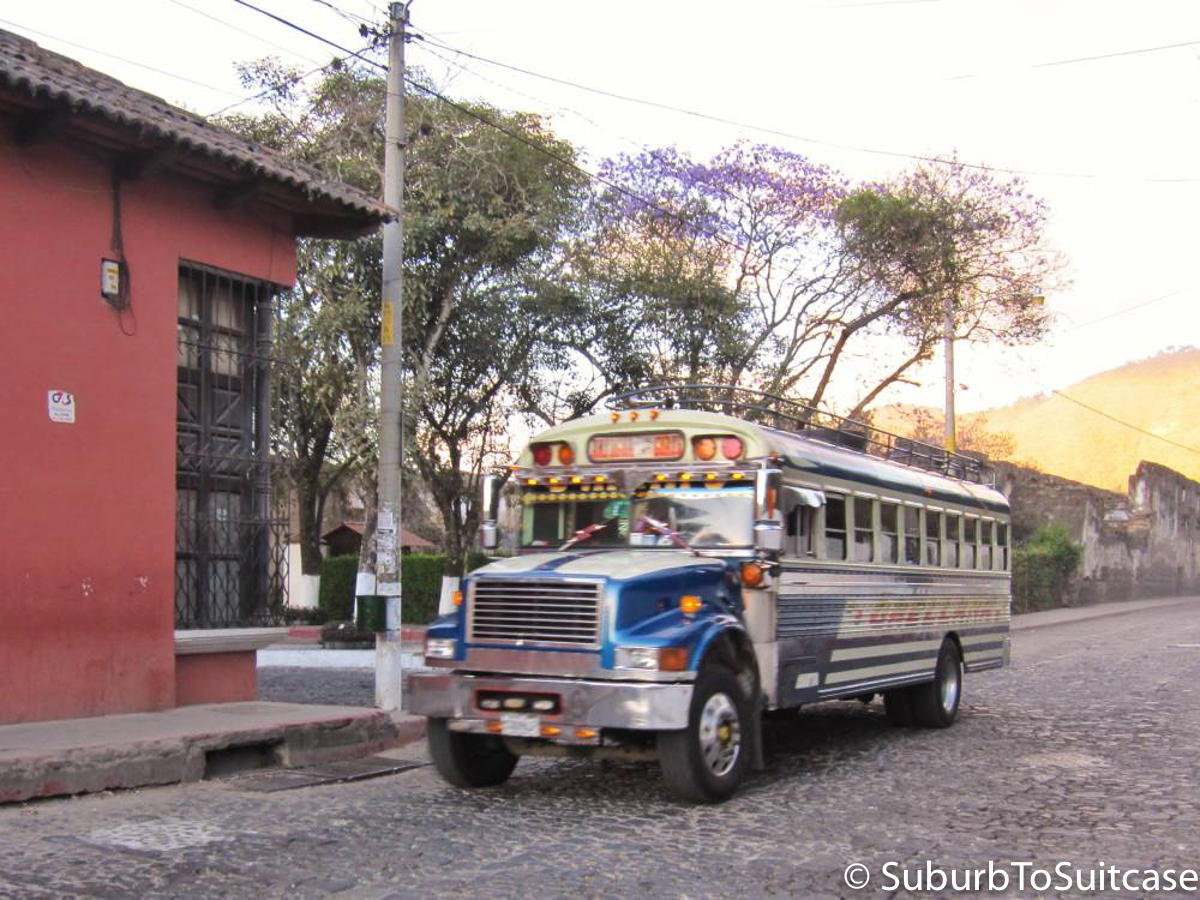
Guatemalan Chicken Bus
Cacao, coffee beans and macadamia nuts are grown in Guatemala. I would recommend a plantation visit if possible to learn more about one of these local industries. On a whim on my last afternoon before departing Antigua, I decided to enroll in a chocolate history class at the local museum just for something different. We learned about how cacao is harvested and then we roasted, peeled and ground our own beans by hand in order to make native hot chocolate drinks (surprisingly bitter). We later made our own dark chocolate treats to take with us on our respective journeys. Pablo was a fun instructor (there is a long-standing joke about everyone calling him Pedro, but he is indeed, Pablo). It was hard for me to leave Antigua because I met some wonderful people there and really felt at home. At this point, I was travel-fluent with my Spanish again too since I had not spoken English since my arrival in El Salvador. It was fun to serve as the translator for some German guests where I stayed who could speak English but not Spanish.
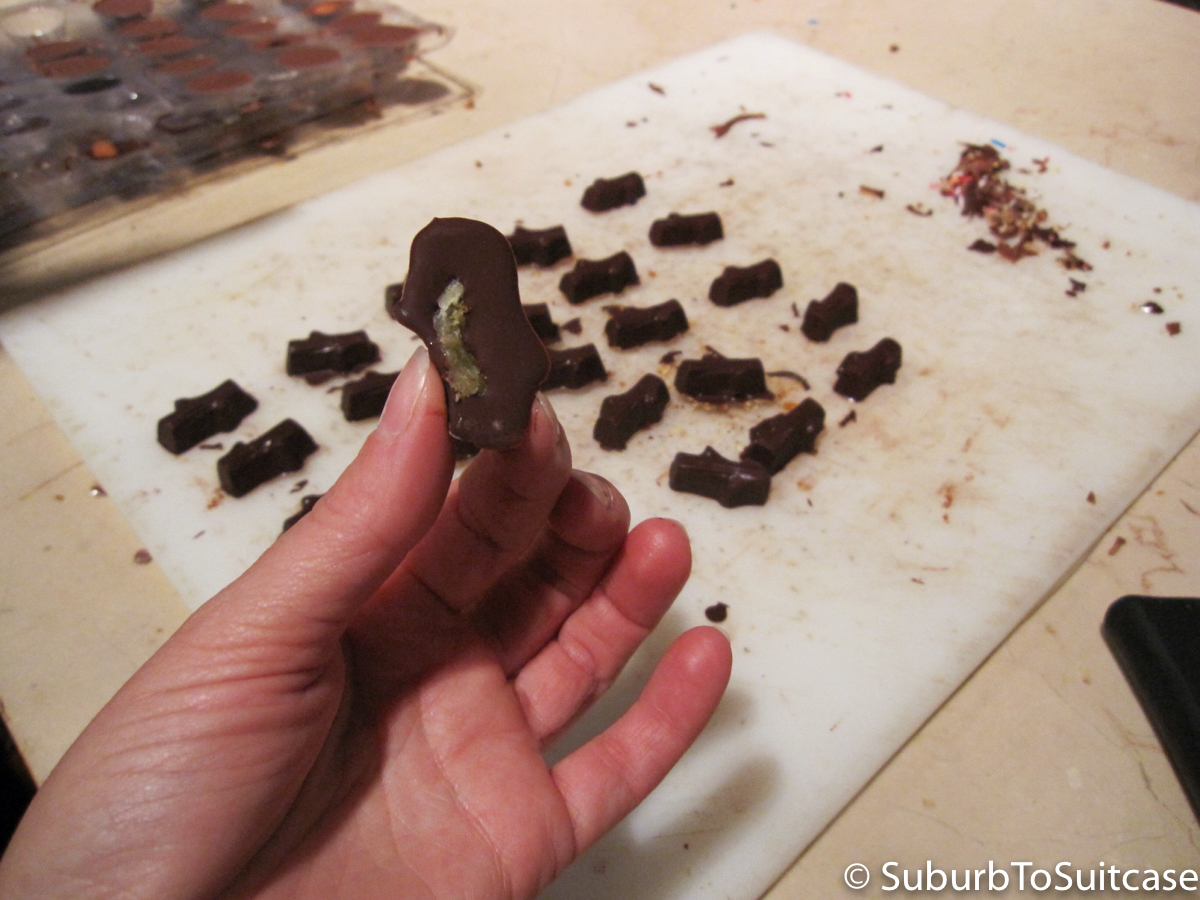
Cacao, coffee and macadamia nuts are grown in many areas of Guatemala. In chocolate making class, we learned the history of cacao production, roasted and peeled cacao beans and then used a mortar and pestle to make a paste for hot chocolate three ways (Mayan, Aztec and Spanish).
Volcan Pacaya
There are day tours from Antigua to Volcan Pacaya and you take a minibus for about an hour drive each way (again, depending on what you encounter along the road). I remember being crammed in the minibus part-way to the volcano and seeing a rather large crowd on foot merging in the from the side street ahead of us. The thing about bus riding is that the only air circulation is from open windows so it is nice when moving at speed to have that natural air conditioning. When the pace slows, it becomes very fast, very quickly. That said, the sight of masses of people gathering near me usually raises my attentiveness anyway when I travel in South America because it could be a political demonstration, dispute, school release or something else to be aware of. In this case, there was peaceful chanting and the vague murmur of music. The crowd was large but moving very slowly and covering the entire road. Many women were carrying umbrellas – they overlapped in such a tight area – and it was evident the mood was somber. As we continued to move with the crowd, we could see that we were one the edge of a funeral procession with the casket riding in the pickup in front of us. Our minibus packed with passengers was silent (a rare moment to find on a bus of any kind). I took the opportunity to remember that while I was so enjoying my travel through this beautiful country, reality was still unfolding all around me. Like many other experiences within this trip, it was humbling.
We finally made it to the volcano for our afternoon trek and sunset descent. The hike is amazing, but challenging due to the loose terrain and steep climb (elevation >8,000 feet). I rode horseback part of the way and climbed the rest. This volcano first erupted 23,000 years ago and it continues to be active. As we approached the top, the volcano was billowing smoke every couple of minutes. It was an incredible sight to witness. We roasted marshmallows in the steam holes which was fun too. It was much faster going down due to the ground conditions (the ash and stone lava from prior eruptions makes for more of a sliding descent at times). At the time of my ascent, the volcano appeared to be on a four year eruption cycle (2006 and 2010). As we made our way back to Antigua, I felt blessed to have been able to visit this volcano. Four days after my descent, and true to four-year pattern (2014), Volcan Pacaya erupted.
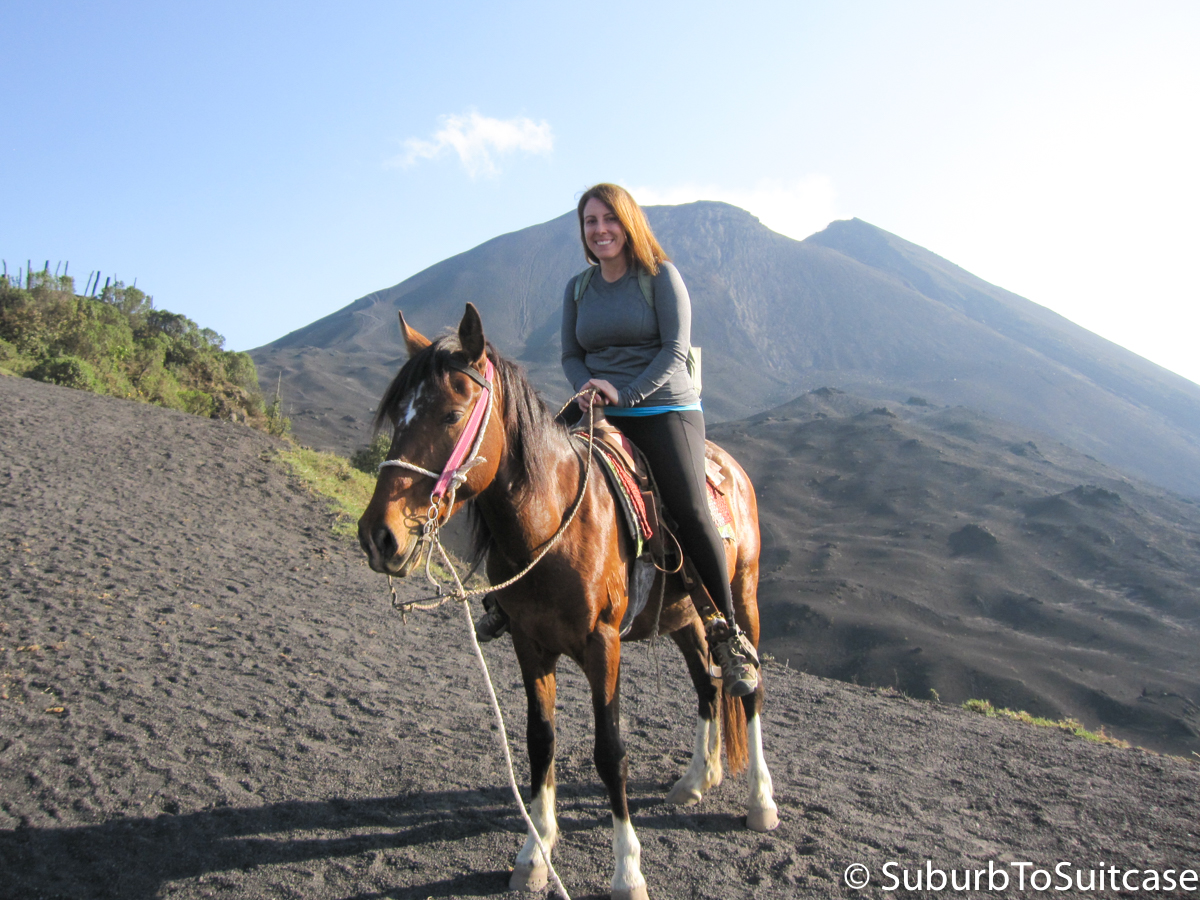
Me at the point where we dismounted horses and needed to climb the rest of the way through the loose lava sand to the top
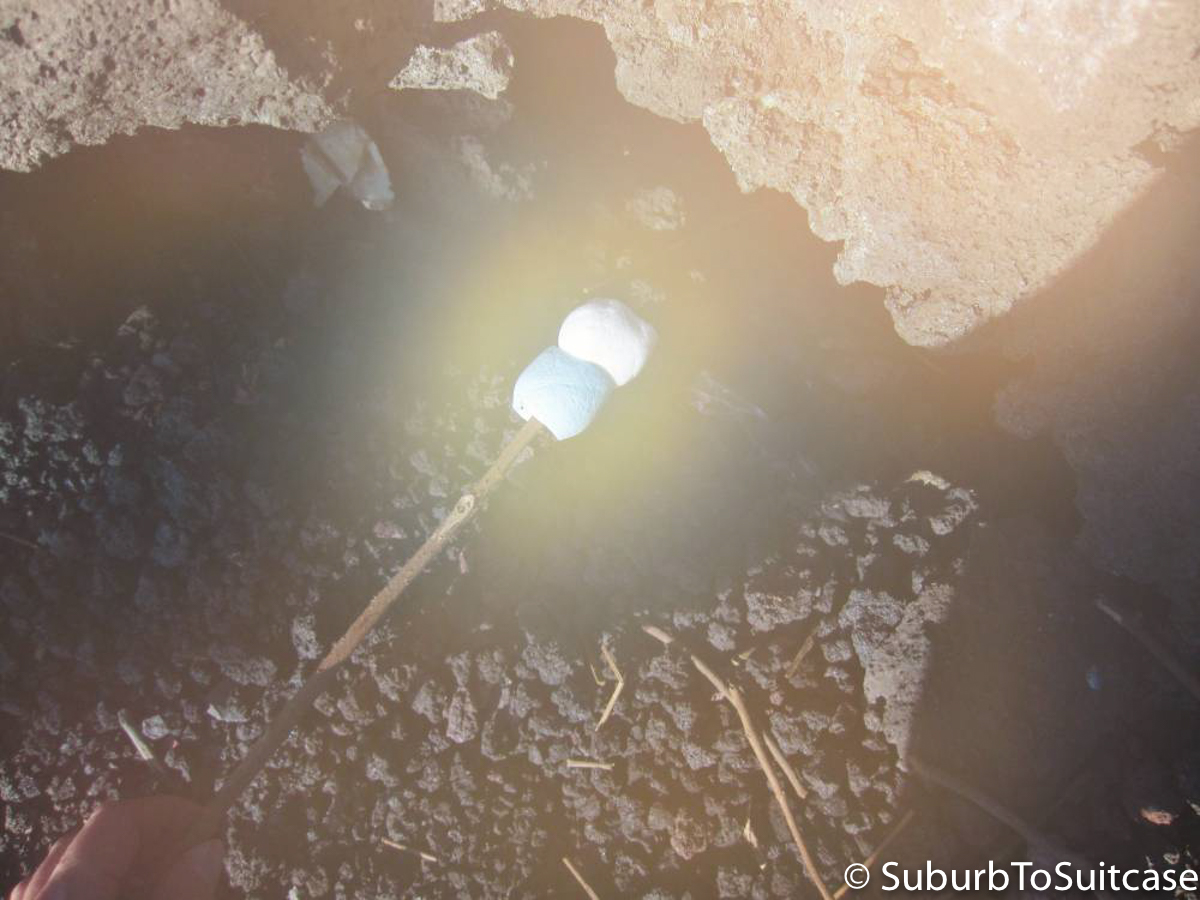
Roasting Marshmallows Over a Steam Vent on Volcan Pacaya
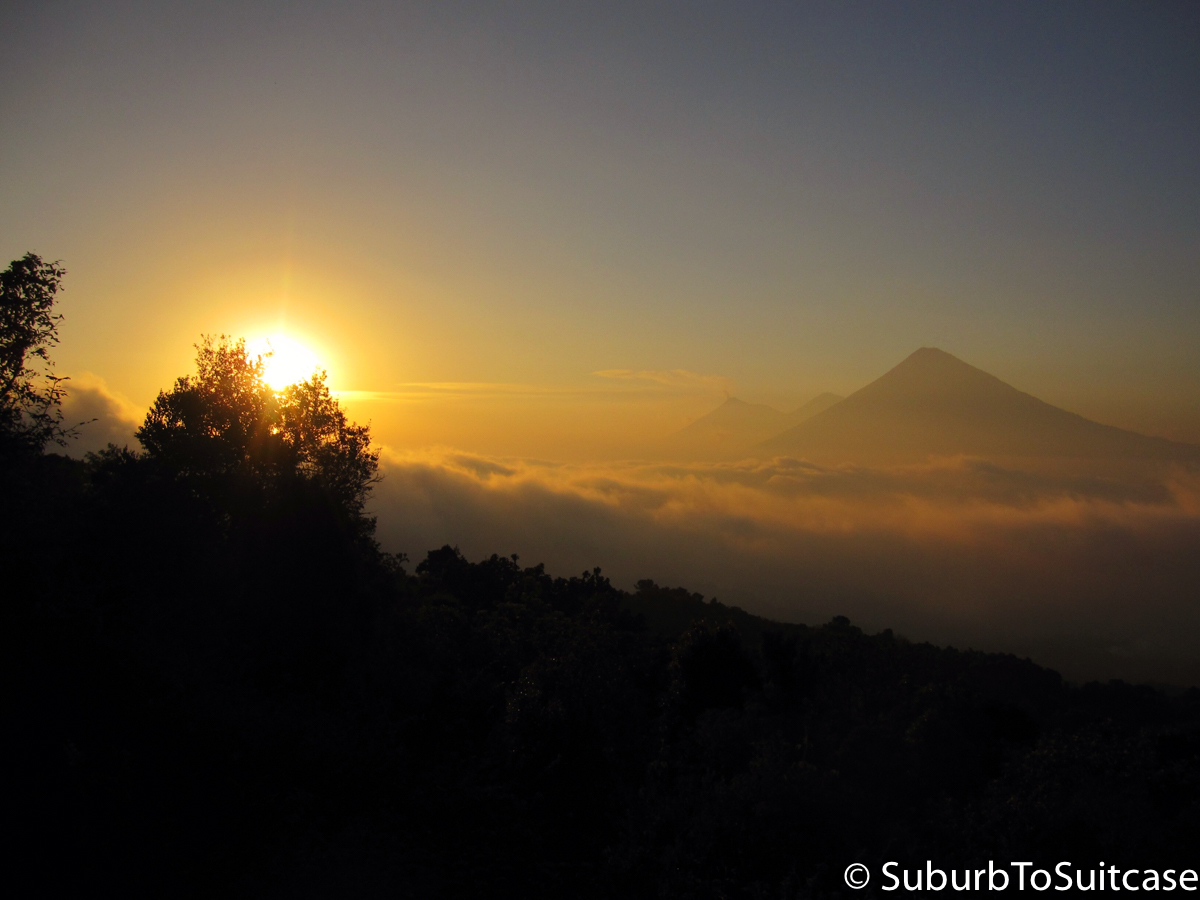
Sunset on the climb down from Volcan Pacaya was spectacular. Three neighboring volcanos are in the background – Agua, Acatenago and Fuego.
Lanquín
The next morning, I was off on a nine hour bus ride through Cobán to Lanquín. It would normally only have been eight hours but the minibus in front of us had a flat tire so we had to stand on the road and wait for them to change the tire (another example of why you have to be flexible here). If you are going on one of these long bus rides, know that there will usually be 2-3 stops along the way for about 10 minutes each – just enough time to use a restroom and buy drinks/snacks at a gas station. Lanquín is pretty much the end of civilization until you hit the jungle.
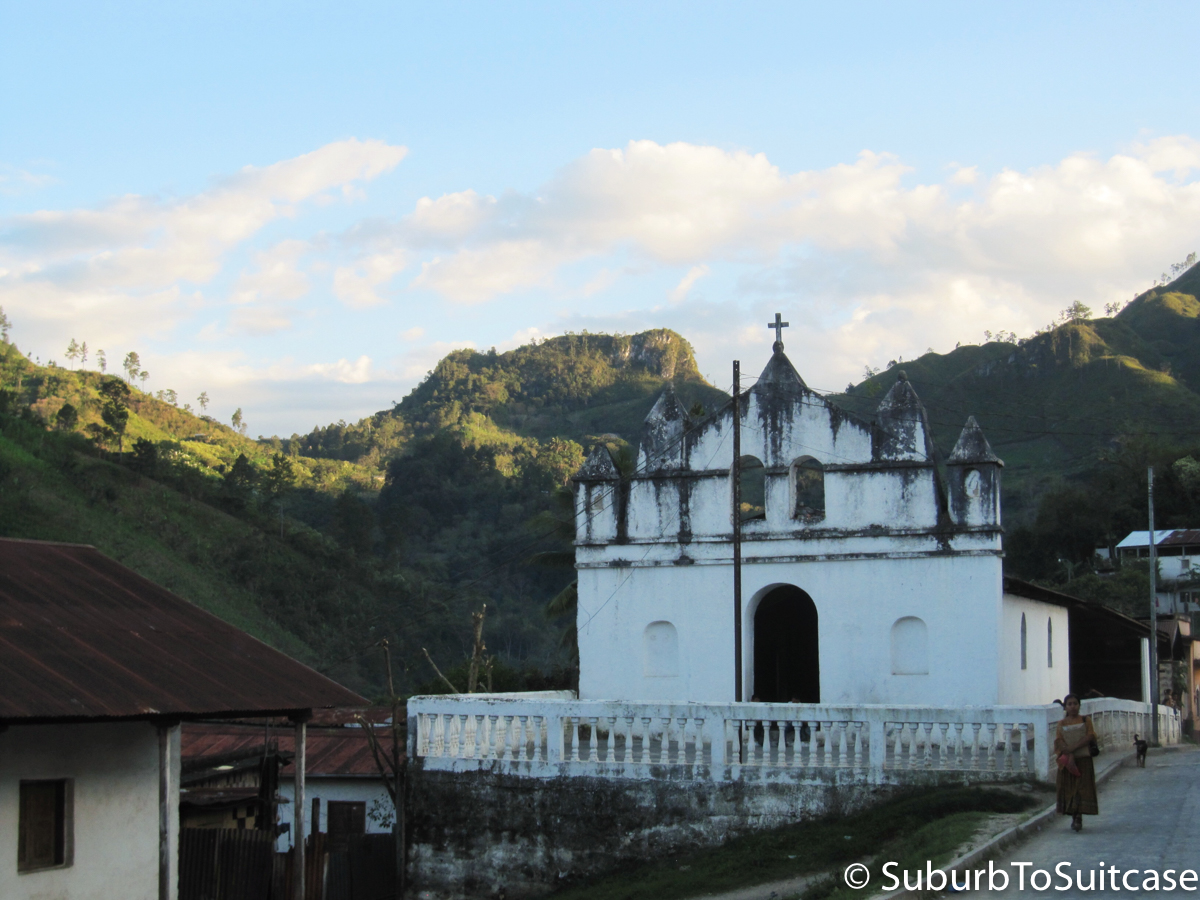
Lanquín is the last municipality before you need to switch to off-road vehicles to head into the jungle.
From the bus stop, you have to transfer to 4WD off-road trucks to take you into the jungle (another 45 minute drive – easier said than done). First, the trucks only go to the jungle when they have enough people. That’s the equivalent of “island time” in the Caribbean. After two hours of waiting, we loaded up a number of locals into the back of the truck and headed out. As it turns out, these trucks serve as taxis of sorts for jungle residents who work in town but need to return to their homes in the evenings. The path (I won’t even call it a road) is narrow, bumpy, dusty but beautifully lined with farmland where maize, cacao and coffee beans grow. Along the edge of the road (even if the side has a cliff), men walk to and from their work on the farms carrying their machetes. Women walk with fruits, vegetables or tortillas in baskets on their heads. It is a humbling ride.
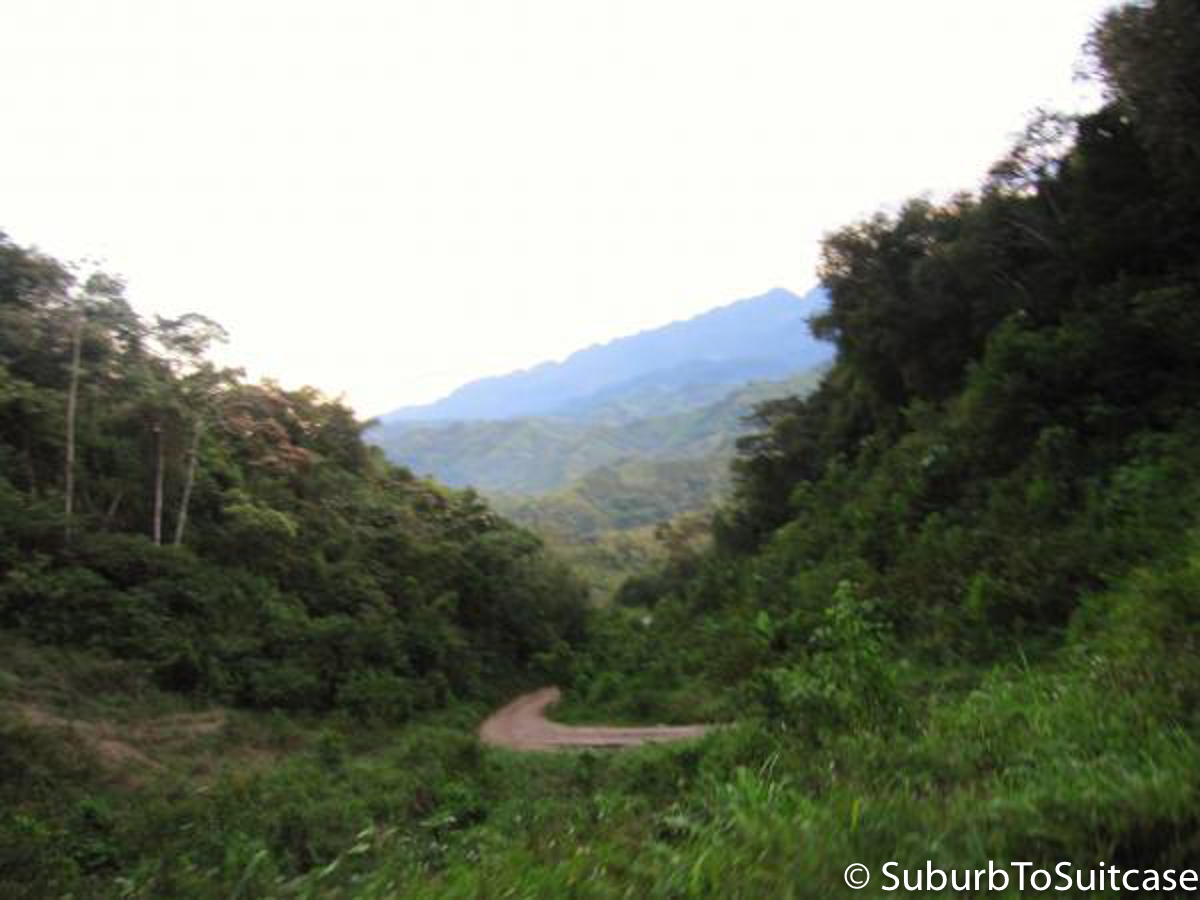
Road to Lanquin
Semuc Champey
The jungle is beautiful but even more serene early in the morning when the only sounds are the river flowing, birds singing, roosters crowing, insects chirping and the rustling of leaves which still remains a mystery (locals claim the active animals are monkeys, jaguars and tigers but I can only attest to spiders and cockroaches the size of a child’s hand). While some might wonder why anyone would come here, those who have gone before know…the ultimate destination is Semuc Champey. This is one of the most beautiful destinations I’ve ever visited.
Here is how the day went:
- Depart hostel standing up in the bed of an off-road truck, holding onto the metal bars over all of the bumps.
- Pass around the fresh-cut cacao pods to suck on (you do not want to bite into these as they are very bitter but the flesh that covers the raw beans is sweet). The guide in the back of the truck bed was impressed I knew about the cacao as the others were learning their lesson not to bite into them. See…that class in Antigua came in handy!
- Arrive 30 minutes later at Semuc Champey to check in at the Kan’Ba caves.
- Wait as your guide applies traditional orange Mayan ink (fresh from the tree pod) to your forehead, nose and cheeks.
- Grab a candle and pass on the flame to your group.
- Enter the caves and descend into the water (expect that at some point, you are going to walk directly into a submerged boulder and get bruised or cut since everything is dark around you and the rocks are impossible to see underwater).
- Crawl, swim, climb and wade through the cave and appreciate the beautiful interior (relighting your candle when you accidentally get it wet on your jumps).
- Climb ladders and ropes up waterfalls to scale the rocks at various levels with care, so as to not slip or fall off the narrow areas you are balancing on.
- Jump from the cave walls into the pools below if you are brave enough (uh yeah…not me).
- Turn around and start your return through the cave, including sliding down your guide’s legs while reaching for a rock formation to grab before the waterfall rushes over you and you plummet into the dark waters below.
- Relight your tiny flame and exit the cave with about an inch of your candle remaining.
- Eat lunch (you’ve earned it).
- Jump from the bridge 45 feet (15 meters) to the river below…if you dare (again, not me).
- Climb the steep 45 minute hike to the mirador where you can look down at the beautiful pools below.
- Hike back down to water level.
- Swim in the waterfalls, jump from the rocks, slide down the rock waterslides in the beautiful natural tiered pools while tiny fish nip at your feet for a free pedicure.
- Grab an inner tube and float down the Rio Cahabón 45 minutes until you jump out at the hostel, waving to children playing along the bank and women washing their clothes in the water (all the while keeping your eyes open for the rocks and rapids where you navigate through the whitewater).
- Shower outside. Note: There are fewer critters before dark so do this sooner than later.
- Eat dinner.
- Crash, knowing you just had one of the most amazing days ever.

Bird’s Eye View of Semuc Champey
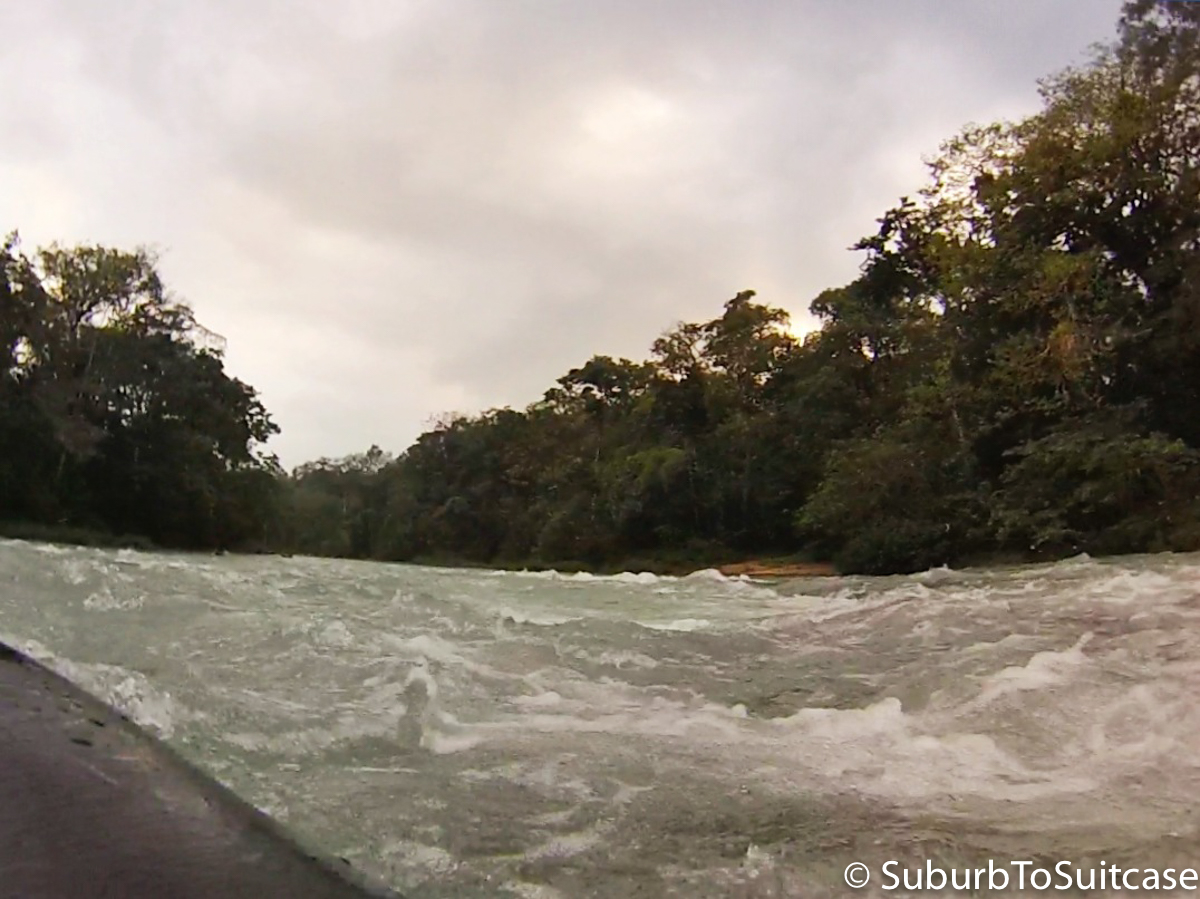
Whitewater Tubing to the Hostel
My journey ultimately ended by way of a bus ride back to Guatemala City where I spent only one day. You have to be careful here as to which zone you travel and/or stay. Not all zones are safe for travelers so research this in advance. My experience in Guatemala was fantastic and I would not have done anything differently except perhaps add more time.
Travel Tips:
- The currency is Guatemalan Quetzal – be sure you convert or withdraw money when it is available. Remote villages do not have ATMs.
- Wear/bring excellent shoes (not good shoes – excellent shoes). You will need them. Hiking boots and water sandals are really important.
- Bring a sense of adventure and try new experiences. If that adventure brings you to the jungle, consider bug repellant or just assume you will have bites and bring antihistamine or topical cortisone.
- Have a travel flashlight.
- Be aware of varying temperatures depending on elevation changes but plan clothing in alignment with cultural norms, especially in places like Antigua.
- For the best experience possible, speak Spanish. Take time to talk to people. Guatemalans were so friendly to me. I felt as though I was family here.
- Purchase souvenirs. It supports the local economy and you will also find many high-quality handmade items at very reasonable prices. There is a big mercado de artesanias where you can find almost anything you could possibly want. If you do not like to negotiate prices, you can also go to Nim Po’t Centro de Textiles Tradicionales which is an artisan coop of sorts on the same street as the big arch. If is a subset of the same items as the mercado at already reduced prices. The big mercado is worth the experience though. If you go, consider buying fresh squeezed orange juice from the señora whose cart is right out front (6Q or ~$0.80 USD). She will serve it to you in a glass container to drink there or “en bolsa” (in a small plastic bag with a straw) if you want to take it while you walk. Delicious.
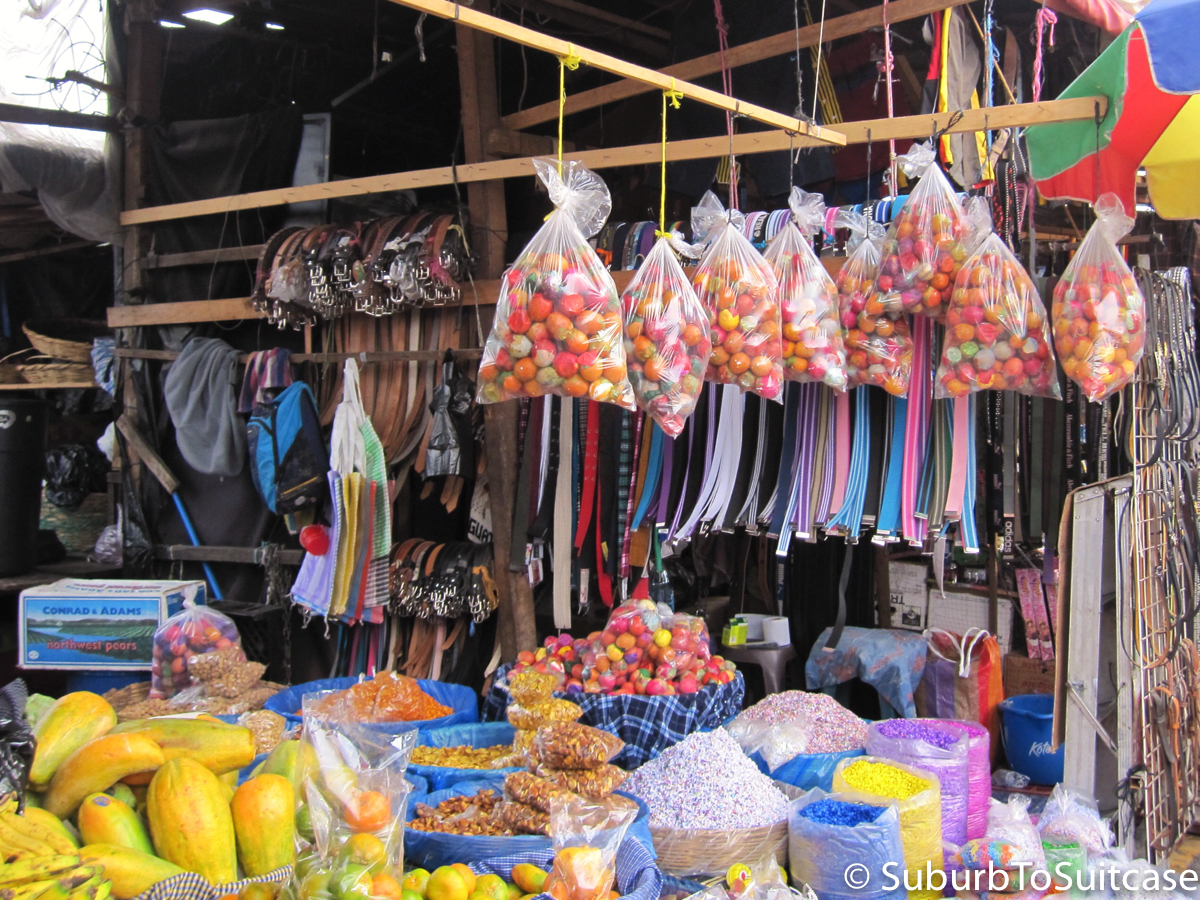
Food, crafts, textiles, toys, toiletries and souvenirs are amongst the stands at the huge mercado in Antigua. Brightly colored “eggs” contain confetti for parties.
- Try the local food! Pepián de Pollo is a deliciously spicy stew of chicken and vegetables served with tamale, rice (to mix in) and fresh tortillas – way more than one girl could eat. For a breakfast splurge, stop in at the Isopan bakery in Antigua. They have THE BEST almond braid pastry (trenza de almendra) for about 4.5Q (~$0.60 USD).
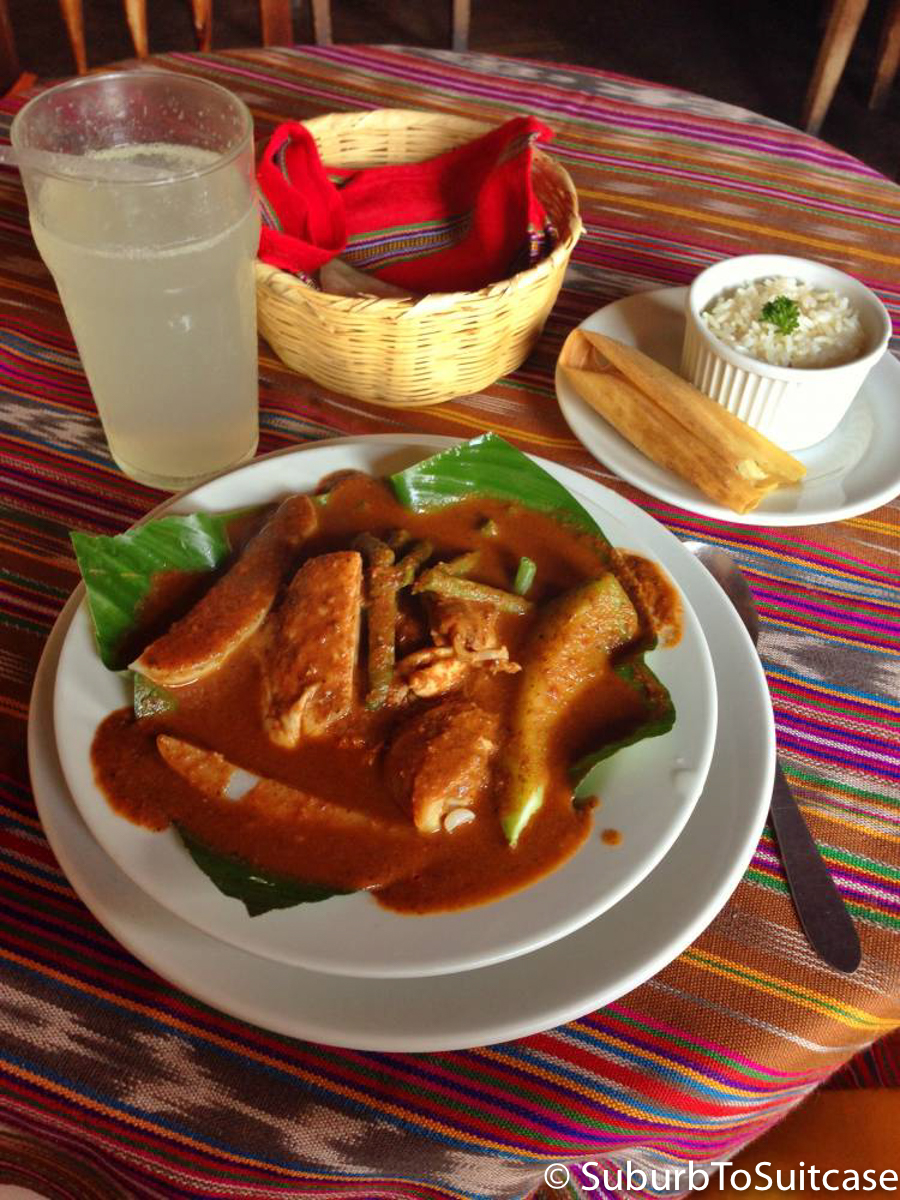
Pepián de Pollo: A travel companion once suggested a splurge meal each trip, so now I carry on that tradition.

Corn tortillas are a staple in Guatemala. Breakfasts normally include coffee, orange juice, eggs, beans, a small wedge of tangy cheese and fresh tortillas.
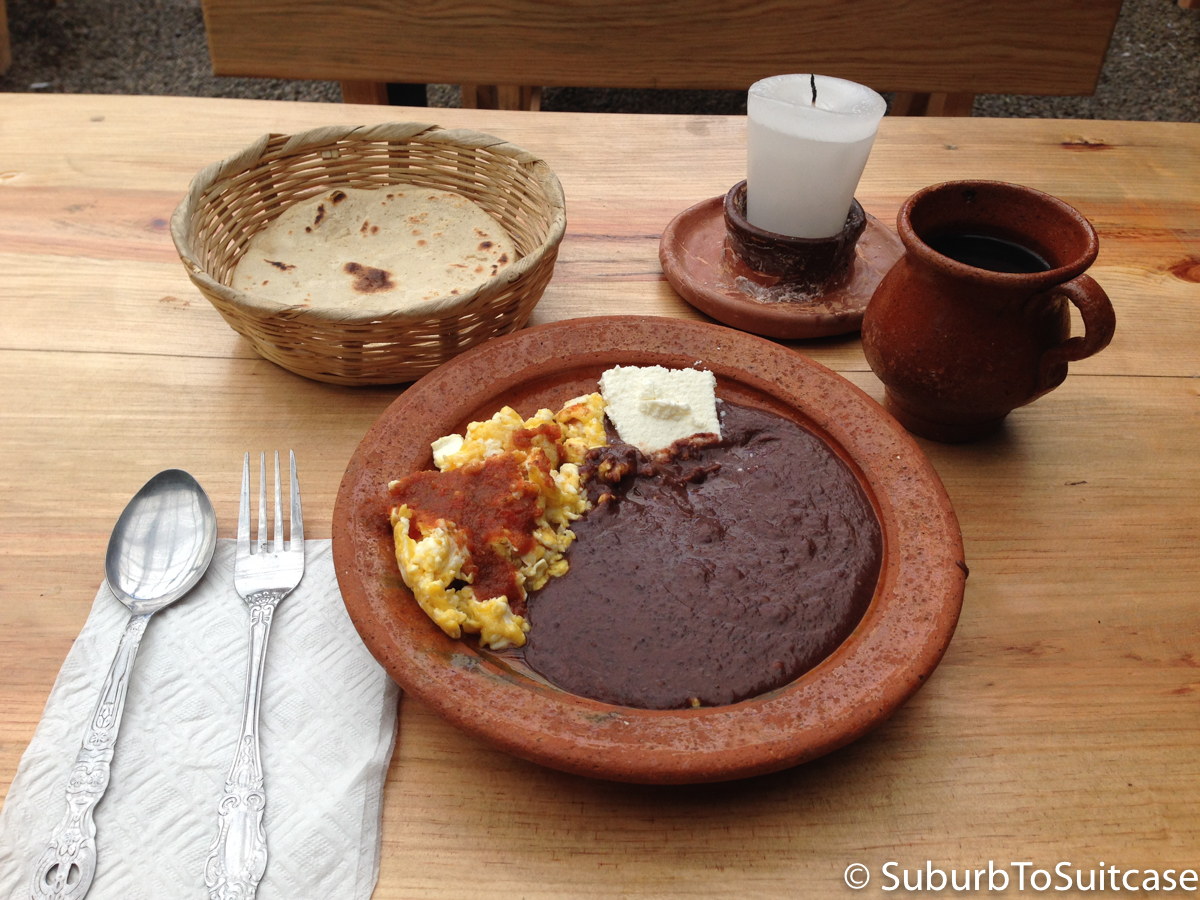
Huevos revueltos (scrambled eggs), frijoles (beans) and queso fresco (cheese) with coffee
